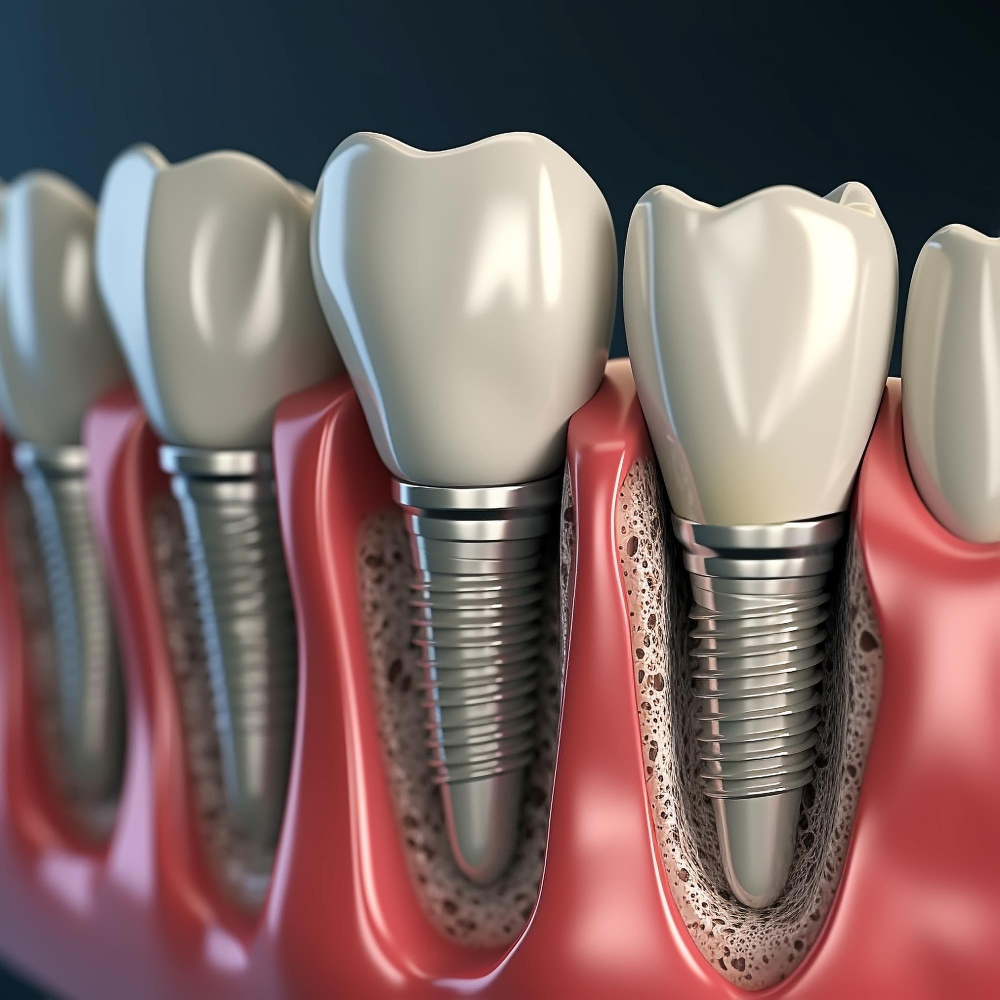Introduction to All-on-X Dental Implants
All-on-X dental implants represent a groundbreaking advancement in the field of dental restoration. These implants offer a reliable and efficient solution for individuals who have lost significant numbers of teeth or require full mouth rehabilitation. Unlike traditional dental implants, which replace one tooth at a time, All-on-X dental implants utilize a strategic approach, using a varying number of implants to support a full arch of prosthetic teeth. Depending on the specific needs of the patient, dental professionals determine the number of implants (often four, six, or eight) required to ensure optimal stability and function, hence the term “All-on-X.”
The primary purpose of All-on-X implants is to provide a fixed, long-term solution for those experiencing severe tooth loss or decay. These implants serve as a solid foundation for prosthetic teeth, ensuring they remain firmly in place and function almost like natural teeth. This method not only restores the aesthetic appearance of a person’s smile but also significantly improves their ability to chew and speak comfortably.
The key difference between All-on-X dental implants and traditional implants lies in their efficiency and less invasive nature. While traditional implants may necessitate bone grafting and multiple procedures over an extended period, All-on-X implants generally require fewer surgeries. The implants are placed at specific angles to maximize contact with the existing bone, often eliminating the need for additional bone grafts. This results in a more straightforward, less time-consuming process, making it an attractive option for many patients.
All-on-X dental implants are particularly recommended for individuals who have lost most or all of their teeth, whether due to advanced periodontal disease, extensive decay, or age-related concerns. They are also suitable for patients seeking a more permanent and stable solution compared to removable dentures. By addressing both functional and aesthetic needs, All-on-X dental implants play a crucial role in the comprehensive restoration of dental health.
The Procedure: How All-on-X Works
The process of receiving All-on-X dental implants involves multiple meticulously planned stages, ensuring optimal results. The journey begins with an initial consultation where the dental specialist conducts a thorough evaluation of the patient’s oral health. This comprehensive examination often includes advanced digital scans and impressions, which help in creating a detailed map of the mouth. These initial steps are crucial for devising a customized treatment plan that addresses the unique needs of each patient.
During the preparatory phase, any existing dental issues, such as gum disease or decayed teeth, are addressed. This ensures a healthy oral environment for the implants. Next, detailed CT scans or digital X-rays are taken to assess jawbone density and structure. This analysis is essential for determining the precise placement of the implants within the jawbone, maximizing stability and success.
The surgical procedure itself is typically completed in a single visit, an advantage of the All-on-X method. Under local anesthesia or sedation, small incisions are made in the gum tissue to expose the jawbone. Titanium implant posts are then strategically inserted into the bone, usually in four to six locations, depending on the patient’s anatomy and specific needs. These implants serve as anchors for the prosthetic dental bridge.
Following the implant placement, temporary prosthetic teeth are attached, allowing patients to leave the office with a functional and aesthetically pleasing smile the same day. This immediate load-bearing approach minimizes downtime and enhances patient comfort.
Post-operative care is crucial for the success of the implants. Patients are provided with detailed aftercare instructions, which include managing any discomfort, maintaining oral hygiene, and dietary recommendations to promote healing. Regular follow-up appointments are scheduled to monitor the healing process and ensure the implants integrate seamlessly with the jawbone.
The final step involves the placement of the permanent prosthetic teeth, once the implants have fully fused with the jawbone, typically within a few months. The custom-made bridge is secured onto the implants, providing a durable and natural-looking replacement for missing teeth, thereby restoring the patient’s oral functionality and appearance.
Benefits of All-on-X Dental Implants
All-on-X dental implants provide a multitude of benefits, making them an advantageous option for those requiring full-arch restoration. One of the primary benefits is improved aesthetics. The design of All-on-X implants allows for a natural-looking smile, as they are tailored to match the patient’s dental profile. Unlike removable dentures, All-on-X implants do not slip or shift, providing a more permanent and aesthetically pleasing look.
Enhanced functionality is another significant benefit. These implants allow consumers to regain nearly their full biting and chewing capabilities, much akin to natural teeth. The stability and strength offered by All-on-X dental implants are unparalleled compared to traditional dentures, which can often lead to discomfort and limitations in food choices.
Additionally, All-on-X dental implants require fewer implants to support a full arch of teeth. This is achieved using strategically placed titanium implants, which serve as sturdy anchors for the prosthetic teeth. Compared to other dental implant solutions, which may necessitate more implants and multiple surgeries, All-on-X is less invasive and often results in faster recovery times.
When compared to conventional dentures or single-tooth implants, the benefits of All-on-X dental implants are compelling. While traditional dentures may be more affordable initially, they often require periodic adjustments and can be uncomfortable, especially for those with sensitive oral tissues. On the other hand, single-tooth implants may not be a feasible solution for those needing extensive restorations and can also lead to higher costs when multiple implants are required.
Overall, All-on-X dental implants offer a comprehensive solution by combining improved aesthetics, enhanced functionality, and higher efficiency in terms of the number of implants needed. This multifaceted approach positions All-on-X dental implants as a superior choice for those seeking a long-term, durable, and aesthetically pleasing solution to full-arch tooth loss.
Who is a Candidate for All-on-X?
Determining the suitability of an individual for All-on-X dental implants involves a multifaceted evaluation process. These advanced dental solutions are ideal for those who have lost multiple teeth or are facing complete tooth loss but wish to avoid conventional dentures. The primary criteria for candidacy include bone density, oral health status, and certain lifestyle considerations.
Bone density plays a critical role in the success of All-on-X dental implants. Adequate bone volume is necessary to support the implants securely. Therefore, individuals with significant bone loss may require bone grafting procedures before being considered for All-on-X. A comprehensive dental examination, which includes imaging tests like X-rays or CT scans, is essential to assess the bone structure and determine if the patient has enough bone to proceed with the implant placement.
Equally important is the overall oral health status of the prospective candidate. The presence of periodontal disease or untreated cavities can pose significant risks to the implant success. Hence, a healthy oral environment free from infection and inflammation is necessary before undergoing the procedure. Any existing dental issues must be addressed and resolved prior to implant placement to ensure optimal outcomes.
Lifestyle factors, such as smoking and certain medical conditions like uncontrolled diabetes, can adversely affect the healing process and success rate of All-on-X dental implants. Smokers may be advised to quit, and individuals with medical conditions should work closely with their healthcare providers to manage their health issues effectively before considering the implant procedure.
Because All-on-X implants require surgical intervention, it is vital that candidates undergo a thorough dental examination and consultation. This step allows dental professionals to evaluate all relevant factors, formulate a treatment plan tailored to the individual’s needs, and discuss any potential risks or complications. Personalized consultations ensure that the patient is well-informed and prepared for the All-on-X dental implant procedure.
Post-Procedure Care and Maintenance
Proper post-procedure care and maintenance are essential to ensure the longevity and success of All-on-X dental implants. Once the implants have been placed, it is important to adhere to a diligent oral hygiene routine. Patients should brush their teeth at least twice daily using a soft-bristled toothbrush and a non-abrasive toothpaste. In addition, using an antimicrobial mouthwash can help to reduce bacteria and prevent infection.
Flossing is another crucial component of oral care. Special flossing tools, such as interdental brushes or water flossers, can effectively clean around the implants and under the dental bridge, ensuring the removal of food particles and plaque. Regular dental check-ups and cleanings are also necessary to monitor the health of the implants and surrounding gum tissue.
Dietary considerations play a significant role in the initial healing phase. Soft foods are recommended during the first few weeks post-procedure to avoid putting excessive pressure on the implants. Gradually, patients can reintroduce firmer foods as healing progresses. It is advisable to avoid hard, sticky, or chewy foods that could damage the implants or cause discomfort. Staying hydrated is equally important, as it helps maintain overall oral health.
Post-procedure care also includes attending follow-up appointments with the dental professional. These appointments are vital for assessing the progress of healing, adjusting the fit of the dental bridge if necessary, and addressing any concerns the patient may have. Consistent follow-up care helps ensure the overall success of the All-on-X dental implants.
Patients should be vigilant about potential complications. Common signs to watch for include prolonged pain, swelling, or signs of infection such as redness and drainage. If any of these symptoms occur, immediate consultation with the dental professional is imperative. Additionally, habits such as smoking can adversely affect the healing process and should be avoided.
By adhering to these guidelines for post-procedure care and maintenance, patients can optimize the functionality and lifespan of their All-on-X dental implants, achieving a healthier and more confident smile.
Comparing All-on-X to Traditional Dentures
When it comes to tooth replacement options, patients often find themselves choosing between All-on-X dental implants and traditional removable dentures. Both have their merits, but notable differences exist in comfort, stability, maintenance, and overall patient satisfaction.
First and foremost, comfort and stability distinguish All-on-X implants from traditional dentures. All-on-X implants are securely anchored to the jawbone, preventing any shifting or movement during daily activities such as eating or speaking. Traditional dentures, on the other hand, rest on the gums and can sometimes slip or cause discomfort due to ill-fitting or changes in the shape of the gums over time. This has been corroborated by a patient, John, who transitioned from dentures to All-on-X implants. John stated, “With my dentures, I was always cautious about eating certain foods. The All-on-X implants have given me the confidence to eat and speak without any fear of slippage.”
Maintenance is another critical area of comparison. Traditional dentures require thorough daily cleaning and overnight soaking. They can also necessitate periodic adjustments or relining to ensure a proper fit. In contrast, All-on-X implants mimic the maintenance routine of natural teeth—brushing, flossing, and regular dental check-ups suffice. This efficient maintenance regime has been favored by many patients, including Linda, who remarked, “Switching to All-on-X implants has simplified my oral care routine. I love the convenience as it feels just like my natural teeth.”
Overall patient satisfaction tends to be higher with All-on-X implants. This is partly because they provide a more permanent solution and eliminate the social insecurities commonly associated with traditional dentures. A case study of sixty-year-old Margaret further demonstrated this: after her All-on-X procedure, Margaret noted an immense boost in her self-esteem and social interactions. “These implants feel so natural, and I don’t have to worry about them at all. It has been a life-changing experience,” she affirmed.
To conclude, while both All-on-X dental implants and traditional dentures serve the purpose of tooth replacement, understanding their differences in comfort, stability, maintenance, and overall satisfaction can significantly impact the choice a patient makes. Individual needs and lifestyle will ultimately dictate the best option, but the experiences of patients who have made the transition to All-on-X implants underscore the significant benefits they offer.
Cost and Financial Considerations
The financial investment in All-on-X dental implants encompasses various components, starting with the initial procedure and extending to potential supplementary treatments and long-term upkeep. Depending on the intricacies involved, the cost can fluctuate significantly. Patients should anticipate charges for preliminary consultations, diagnostics, the surgical procedure itself, and post-operative care. Moreover, additional expenses may arise from auxiliary treatments such as bone grafts, which some patients might require to ensure sufficient bone density for implant support.
Longevity is a hallmark of All-on-X dental implants, necessitating regular maintenance to uphold oral health and implant stability. Periodic check-ups, professional cleanings, and potential replacement of prosthetic components over time are factors contributing to ongoing costs.
When delving into payment structures, a variety of options exist to alleviate the financial burden. Many dental clinics offer payment plans, allowing patients to distribute the cost over a set period. This approach ensures that high-quality dental care remains accessible without necessitating a substantial upfront payment. Additionally, dental insurance may cover a portion of the expenses associated with All-on-X implants, particularly if the procedure is deemed medically necessary. Assessing the specifics of one’s insurance plan is crucial to determining potential coverage and reimbursement.
Furthermore, financing options are available through various lenders specializing in medical and dental expenses. These financial institutions provide structured plans, accommodating different budgets and ensuring that patients can manage payments comfortably. Exploring these avenues is advisable to identify the most suitable arrangement, enabling patients to proceed with their dental restoration goal
Success Rates and Patient Outcomes
All-on-X dental implants have garnered significant attention for their high success rates, which are well-documented in various clinical studies. Recent research shows that the success rate for All-on-X procedures ranges from 95% to 98%, showcasing the reliability and effectiveness of this dental solution. These statistics are a testament to the technological advancements in dental implantology and the growing expertise of dental professionals performing these procedures.
Patient outcomes for All-on-X dental implants have been overwhelmingly positive, with many patients reporting a marked improvement in their quality of life. The comprehensive nature of the All-on-X system, which often involves replacing a full arch of teeth on as few as four implants, provides a stable and natural-looking solution for individuals with significant tooth loss. This stability often translates into enhanced chewing efficiency, clearer speech, and a boost in self-confidence.
Anecdotal evidence further supports the robust clinical data on All-on-X success rates. For instance, Jane, a 55-year-old patient who underwent the All-on-X procedure, shares that she can now enjoy a wider variety of foods without discomfort and is more confident in social settings. Similarly, another patient, John, highlights the life-changing impact of the implants, noting significant improvements in his oral health and overall well-being.
These positive patient experiences echo the findings in clinical settings, where All-on-X implants are not only noted for their high success rates but also for their durability and longevity. Many patients have reported sustained benefits years after the procedure, underscoring the long-term efficacy of All-on-X dental implants. From a clinical perspective, the minimal surgical invasiveness and reduced treatment times further contribute to the favorable outcomes observed in patients.
In summary, the All-on-X dental implant system stands out for its exceptional success rates and profound impact on patient outcomes, offering a reliable, long-term solution for those facing extensive tooth loss.









